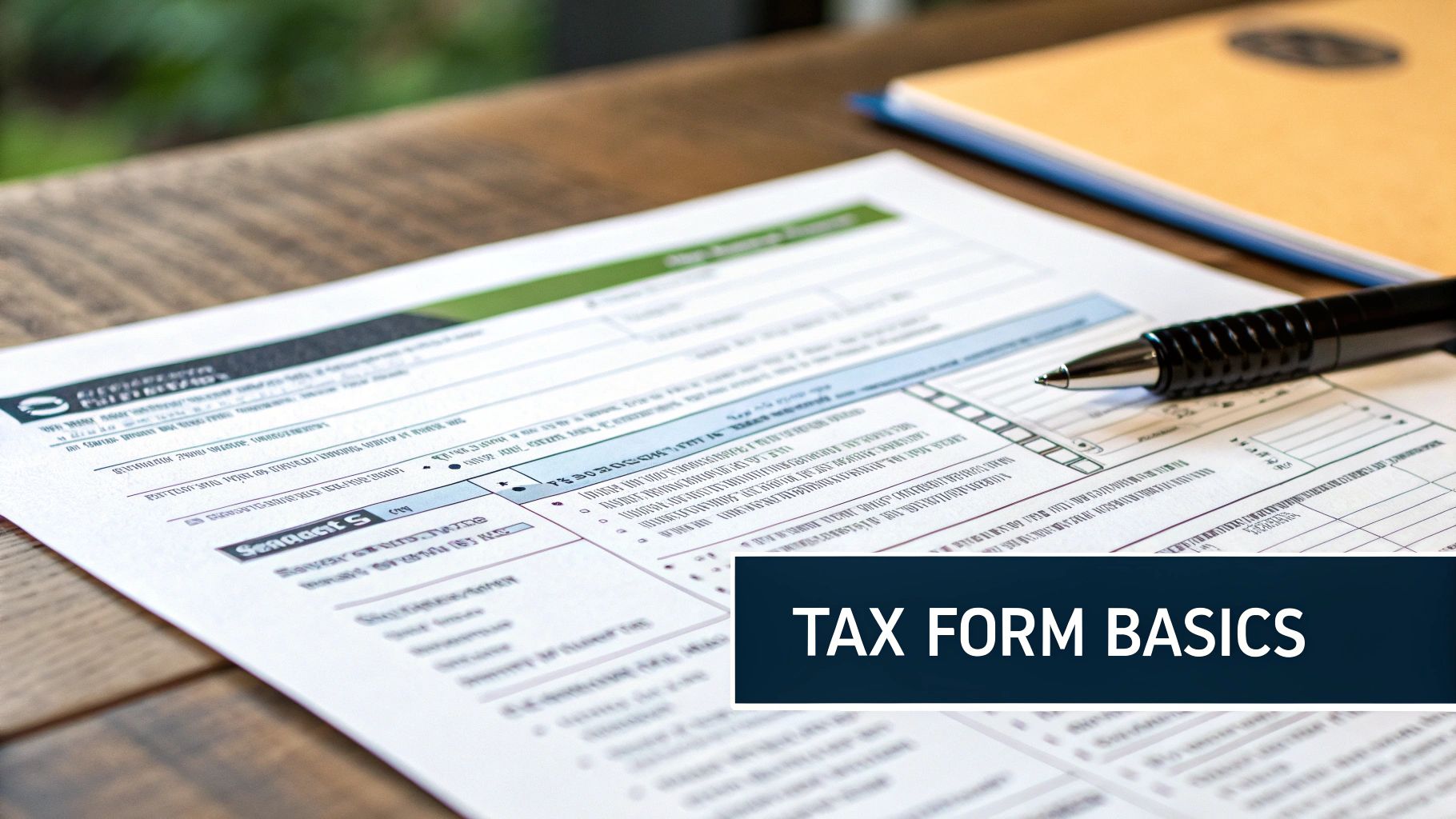Getting Started With Options Trading Taxes

The world of options trading taxes can feel overwhelming at first, but understanding the basics is essential for both your profits and peace of mind with the IRS. When you break it down step by step, the tax rules become much clearer. Making smart trading decisions isn't just about picking winning options contracts – it's also about knowing how those trades will affect your tax bill at the end of the year.
Key Concepts in Options Trading Taxation
The tax treatment of your options trades depends on a few key factors. The most important is the type of option you're trading – equity options and index options follow different tax rules. Another crucial factor is how long you hold each position. Your holding period determines whether profits get taxed as short-term or long-term capital gains, which can make a big difference in your final tax rate.
Different Trading Styles and Their Tax Impact
Your trading style directly affects how much you'll pay in taxes. Day traders and short-term options traders typically pay higher rates since their profits count as ordinary income. On the flip side, holding positions longer can qualify you for lower long-term capital gains rates. Index options get special treatment under Section 1256 of the tax code – 60% of gains are automatically treated as long-term, no matter how brief you held the position. For instance, if you made $50,000 trading index options, you'd pay about 23% in taxes and keep $38,500 after tax.
Common Misconceptions That Can Cost You
Some common tax myths can take a bite out of your trading profits if you're not careful. Many traders wrongly assume all options follow the same tax rules. In reality, the tax treatment varies quite a bit based on the option type and holding period. Another costly mistake is forgetting about the wash-sale rule – if you sell at a loss but rebuy a similar position within 30 days before or after, you can't claim the loss. This applies to equity options but not Section 1256 contracts like index options.
Organizing Your Trades for Tax Efficiency
Good recordkeeping makes tax time much easier when you trade options. Track every trade's entry and exit prices, dates, and fees so you can accurately calculate your gains and losses. Clean records also help you use strategies like tax-loss harvesting – deliberately taking losses to offset gains. For example, a $10,000 trading loss lets you deduct $3,000 against regular income and save the remaining $7,000 for future years. With organized records and a solid grasp of the rules, you can turn tax planning into an advantage for your trading.
Mastering the 60/40 Rule and Section 1256 Contracts
Tax considerations can significantly impact your bottom line when trading options. Two key concepts that every options trader should understand are Section 1256 contracts and the 60/40 rule, as they can help reduce your tax burden and increase after-tax profits.
Understanding Section 1256 Contracts
Section 1256 contracts are specific financial instruments defined by the Internal Revenue Code. These include nonequity options (such as index options), futures contracts, and certain foreign currency contracts. What makes these contracts special is their unique tax treatment, which can lead to meaningful tax savings compared to regular equity options.
Decoding the 60/40 Rule
The 60/40 rule is what makes Section 1256 contracts particularly attractive from a tax perspective. Under this rule, any gains or losses from these contracts are automatically split: 60% is treated as long-term capital gains/losses, while 40% counts as short-term – no matter how long you actually held the position. This means that if you make $10,000 trading index options, $6,000 gets taxed at the lower long-term rate, even if you only held the position for a day or two.
Tax Implications of Section 1256 and the 60/40 Rule
The tax savings from the 60/40 rule can be substantial. Let's look at a real example: If you're in the 35% tax bracket and make $50,000 trading index options, you'll pay about 23% in total taxes thanks to the 60/40 split. This means keeping $38,500 after taxes, instead of paying $17,500 if it was all taxed as ordinary income. This difference shows why many active traders focus on Section 1256 contracts rather than regular equity options.
Practical Application: Maximizing Tax Efficiency with Section 1256
To make the most of these tax benefits, consider incorporating Section 1256 contracts into your trading strategy. For instance, two traders each making $20,000 might have very different tax outcomes. The trader dealing exclusively in equity options could face up to 37% in taxes, while someone trading index options under Section 1256 rules would pay significantly less thanks to the 60/40 split. This tax advantage compounds over time, making a real difference in long-term wealth building. Smart traders consider these tax implications when choosing which options markets to trade, helping them keep more of their hard-earned profits.
Understanding Options Tax Classifications

The tax treatment of options trading directly impacts your bottom line. Different types of options come with specific tax classifications that determine how your profits and losses are treated. Understanding these classifications helps you make smarter trading decisions and manage your tax obligations effectively.
Equity Options: How Taxes Work
When trading equity options linked to individual stocks, timing matters. If you sell an equity option within one year of purchase, your profits are taxed as short-term capital gains at your regular income tax rate – which could be up to 37%. However, holding an option for more than a year qualifies your profits for the lower long-term capital gains rate. For instance, if you're in the 35% tax bracket, waiting that extra time could drop your tax rate to just 15% on those gains.
Index Options and Section 1256 Benefits
Trading index options comes with a notable tax advantage through Section 1256 classification. These options, which track market indices, receive special tax treatment under the 60/40 rule. This means that regardless of how long you hold the option, 60% of your gains are taxed at the lower long-term rate while 40% face short-term rates. Let's say you make $50,000 trading S&P 500 index options – thanks to this split, you'd pay around 23% in taxes instead of potentially higher rates, keeping about $38,500 after taxes.
Other Derivatives and Tax Considerations
The tax benefits of Section 1256 extend beyond index options to include futures and foreign currency contracts. Each type of derivative comes with its own specific tax rules and requirements. When building complex trading strategies using multiple derivatives, it's essential to factor in these varying tax treatments. For example, mixing equity options with index options requires careful tracking of different holding periods and tax rates. By understanding these distinctions, you can structure your trades to minimize taxes while maximizing returns. This knowledge helps you create trading strategies that work better for both your investment goals and tax situation.
Strategic Loss Harvesting and Position Management
Managing losses effectively is just as crucial as generating profits when trading options. By strategically using losses to offset gains through loss harvesting, traders can reduce their tax burden significantly. Let's explore some practical approaches to loss harvesting that can help turn losing trades into valuable tax advantages.
Timing Your Exits for Maximum Tax Benefit
When you exit a position matters greatly for tax purposes. For example, if you hold an equity option for more than a year, your profits qualify for long-term capital gains rates, which are typically lower than short-term rates. But there's an important balance to strike – while holding positions longer might save on taxes, it could also lead to bigger losses if the market moves against you. Keep in mind the wash-sale rule too: selling an option at a loss and buying a similar one within 30 days means you can't claim that loss on your taxes.
Balancing Trading Objectives With Tax Benefits
Finding the sweet spot between profit potential and tax efficiency takes careful planning. For instance, if you've made good money trading index options this year, you might look for opportunities to realize losses in your equity options positions to offset those gains. While tax benefits are worth considering, they shouldn't override your core trading strategy. Your primary focus should remain on making sound trading decisions based on market conditions and your analysis.
Record Keeping for Loss Harvesting
Good records make all the difference when implementing a loss harvesting strategy. Here's what you need to track for each trade:
- Entry and Exit Prices: These numbers form the foundation for calculating your gains and losses
- Dates of Trades: Keeping precise dates helps determine your holding periods and applicable tax rates
- Fees and Commissions: Don't forget these deductible expenses that reduce your taxable trading income
Using a simple spreadsheet or trading journal can help organize this information efficiently. Having detailed records not only helps you file accurate tax returns but also provides documentation if the IRS ever questions your strategy. By maintaining clear records, you can turn what might seem like paperwork into a powerful tool for reducing your tax burden while improving your trading results.
Avoiding Common Tax Pitfalls in Options Trading

Tax implications can make or break your success with options trading. Even experienced traders sometimes overlook critical tax rules that end up eating into their profits. Understanding these potential pitfalls is essential for protecting your trading returns. Let's examine the most important tax considerations and practical ways to handle them effectively.
The Wash-Sale Rule and Options Trading
The wash-sale rule trips up many options traders, often without them realizing it. This IRS rule prevents you from claiming a loss if you repurchase a "substantially identical" option within 30 days of selling at a loss. For instance, if you sell an Apple call option at a loss and buy another Apple call with matching strike price and expiration within 30 days, you can't deduct that loss. While this primarily affects stock options, there's good news – the rule doesn't apply to Section 1256 contracts like index options. Being aware of this distinction helps you plan your trades more strategically.
Navigating the Straddle Rules
Trading straddles – holding both calls and puts on the same asset – comes with specific tax challenges. The straddle rules can prevent you from claiming losses until you close out your entire position. This timing issue matters a lot for tax planning. Say you have a losing put option but still hold the corresponding call – you might need to wait until closing the call position before claiming that put loss. Understanding these implications before opening straddle positions helps you avoid unwanted tax surprises.
Mark-to-Market Accounting for Section 1256 Contracts
If you trade index options, you need to know about mark-to-market accounting under Section 1256. This rule means your positions are treated as if you sold them on December 31st, even if you're still holding them. While this lets you use paper losses against gains, it also means paying taxes on unrealized profits. For example, if your index option goes up $5,000 by year-end but you haven't sold it, you still owe taxes on that gain. Planning for these phantom tax bills is crucial for your trading strategy.
Practical Strategies for Avoiding Tax Pitfalls
Good record-keeping forms the foundation of smart tax management in options trading. Track every trade's details – entry and exit prices, dates, and all fees. Consider working with a tax professional who understands options trading to help structure your approach. You might time your trades around holding periods for better capital gains treatment, or focus more on index options to benefit from the 60/40 tax treatment of Section 1256 contracts. The key is having a clear plan that considers both trading and tax implications together.
Building Your Tax-Smart Trading Strategy

Making money in options trading isn't just about executing profitable trades – it's also about keeping more of what you earn through smart tax management. By thinking about taxes while you trade, keeping detailed records, and getting expert help when needed, you can significantly boost your bottom line returns. Let's explore how to build a trading approach that's both profitable and tax-efficient.
Integrating Tax Planning Into Your Trading Decisions
Smart tax planning should be part of your daily trading routine, not an afterthought. One of the most important factors to consider is how long you hold your positions. For instance, if you keep an asset for over a year, you may qualify for long-term capital gains rates as low as 15% instead of being taxed at ordinary income rates up to 37%. On a $10,000 profit, that could mean keeping an extra $2,200. The type of options you trade matters too – equity options and index options face different tax treatment. Understanding these differences helps you pick the most tax-efficient markets for your strategy.
Maintaining Immaculate Records for Tax Season
Good record-keeping is essential for managing your tax obligations effectively. Track every trade's entry and exit prices, dates, and fees in detail. This makes it much easier to calculate your gains and losses when tax time comes. Careful records also let you use strategies like tax-loss harvesting to reduce what you owe. For example, you can use up to $3,000 in losses to offset your regular income, with remaining losses carried forward to future years. What seems like tedious bookkeeping can actually be a powerful tool for keeping more of your trading profits.
Working Effectively With Tax Professionals
While you can handle options trading taxes on your own, working with a qualified tax expert often pays off. A professional who knows options trading can give you specific advice for your situation and help structure your trading to minimize taxes. They can guide you through complex rules about wash sales and straddles so you avoid costly mistakes. Their expertise frees you to focus on trading while ensuring your tax obligations are handled properly.
Practical Approaches to Tax-Smart Trading
To trade in a tax-smart way, take concrete steps throughout the year. Start by setting up a system to log all your trades, whether in a spreadsheet or trading journal. Review your performance regularly, looking at both profits and tax impact. This lets you adjust your approach as needed to maximize tax efficiency. Consider using specialized software to automate record-keeping and tax reporting – this saves time and helps prevent errors.
Ready to make tax management easier and improve your trading results? Coverd helps you track trades and generate insights efficiently. Visit https://coverd.io today to see how we can help streamline your options trading.

Leave a Reply